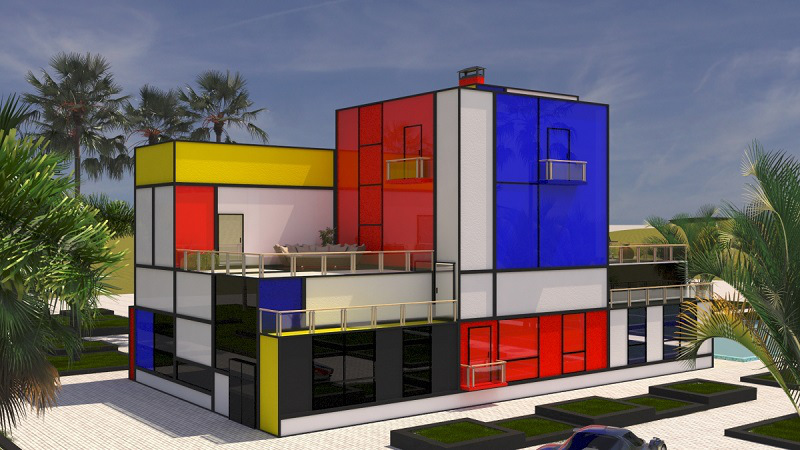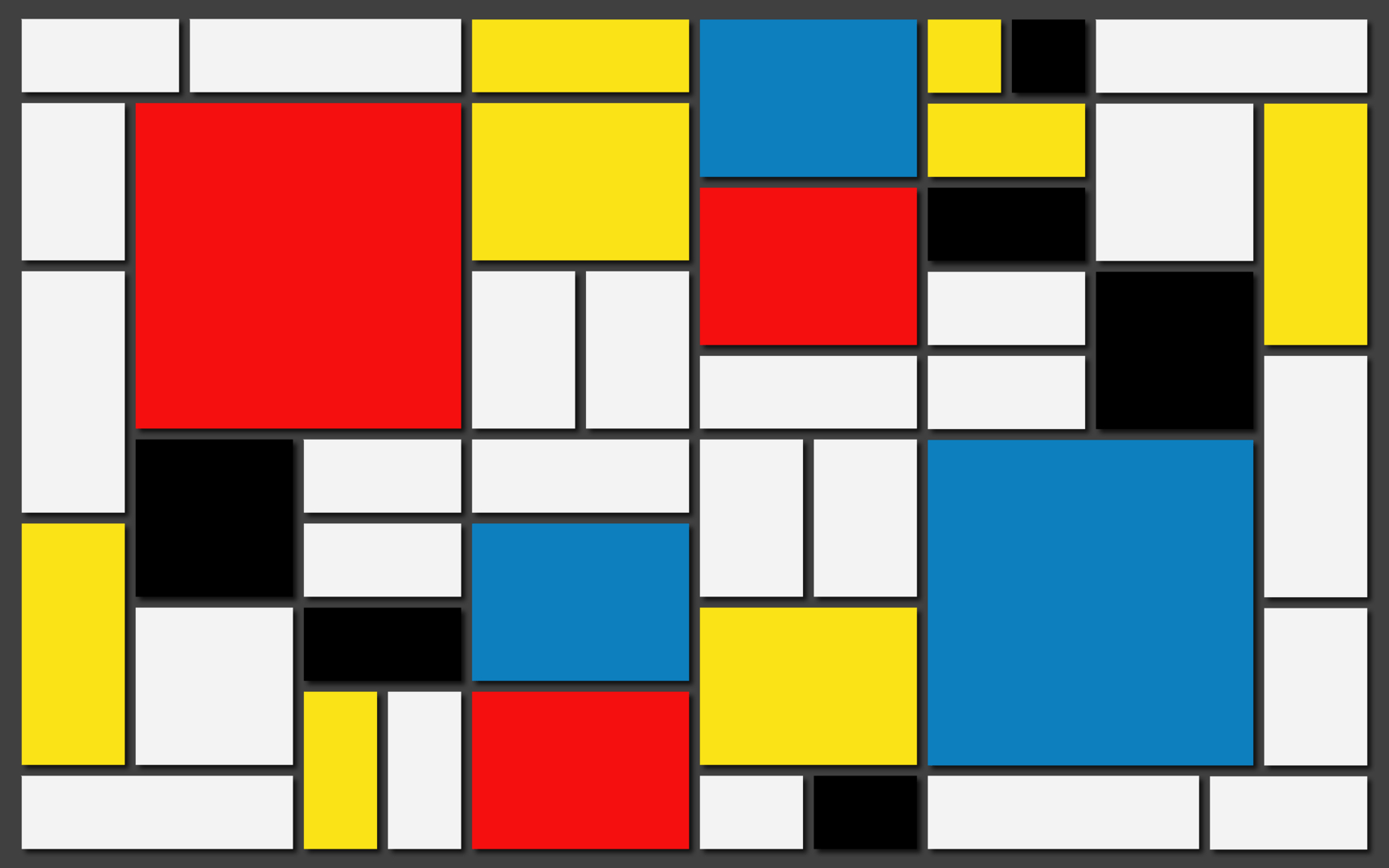Not many people know this but Piet Mondrian had the reputation of being a designer rather than a painter when he first arrived in New York in 1940. Born in the Netherlands, Mondrian initially trained as a traditional artist before evolving towards abstraction. He is regarded as the spiritual leader of the De Stijl Movement and the creation of neoplasticism. The movement was categorised by the use of geometric shapes, primary colours and a grid structure. Mondrian’s influence extended beyond art into the realms of design and architecture, as discussed before, making him one of the leading figures of modern art and a frontrunner for minimalism. Piet Mondrian believed in the potential for harmonious integration of his abstract principles with the built environment. Through the course of this article we shall learn more about Piet Mondrian’s evolving theories on modern architecture and discourse around the subject.
Mondrian’s Influence on Gerrit Rietveld’s Architecture

Mondrian’s influence was seen in the 1920s architecture of Gerrit Rietveld’s Schroder House, Rietveld collaborated with fellow De Stijl member Theo van Doesburg on a number of striking interiors in Amsterdam, too. There was a formal resemblance between the polychrome facade of the house and the neoplasticism works of Mondrian. However, the architect in many cases refuted the influence of the painter on his architecture, rather pointed out the influence of the De Stijl movement and its entire theoretical analysis onto his work. Rietveld went on to caution against the direct application of Mondrian’s composition to architecture, fearing that it may just reflect “decorative prettiness” However in his defence, in the autobiography published in the catalogue of his first one-man exhibition in New York in 1942, Mondrian wrote: “Modern architecture and industry responded to our influence, but painting and sculpture were little affected.”(1) Mondrian went on to defend his art from being mere decorative, immediately stating “ They seemed to fear that Neoplasticism might lead to ‘decoration.’ Actually, there was no reason for this fear in pure plastic art any more than in any other art expression. All art becomes ‘decoration’ when depth of expression is lacking.”(2) Mondrian went on to acknowledge his work’s influence on the interiors and architecture of some architects and warned against the application leading to mere decorative prettiness. He went on to even criticise the regressive character of contemporary pictorial and sculptural production at the time.

His works inspired asymmetric and sparing spaces, the artist’s grids, planes and careful use of colour was easily scaled up,which instantly provided a blueprint for minimalist yet visually engaging designs. Despite having that impact on the built environment, people assumed its impact to be purely utilitarian in nature. Mondrian believed till the end of his life that the realisation of neoplasticism would occur in the future.
Mondrian’s Evolving Theories on Architecture
J.J.P. Oud (1890–1963), an urban architect practising in Rotterdam, published essays and projects in the periodical De Stijl and had managed to heavily influence Mondrian in his evolving views on urban architecture. This led to a continuous correspondence between Mondrian and Oud which highlighted a distinction between practical and pure architecture. Mondrian was now of the belief that the aspect of “utility” should be abandoned and architects should strive to look at buildings as works of art. He stated “Utilitarian objects become beautiful through their basic form, that is, in themselves. Yet they are nothing in themselves: they become part of the architecture through their form and colour.” (3) Nevertheless, he renounced the idea of utility and stated that “it can even limit beauty.” (4).
Mondrian’s Theory on Colour, Material and More in Architectural Structures
Mondrian acknowledged the role of colour in supporting or annihilating architecture, advocating for the active role of colour in consolidating or even opposing real construction. He actively praised the possibilities of new materials like iron and concrete, Mondrian expressed contradictions regarding the use of brick, indicating its limitations and potential opposition to neoplastic principles.
Mondrian’s engagement with architecture showcased a complex perspective which took years to develop. He argued about balancing the tension between practical necessity and pure aesthetic ideals within the context of neoplasticism. His critiques of functionalism and traditional materials reflected an evolving vision for the role of art in architecture, emphasising the ultimate integration of neoplastic principles into architecture-as-art.
Mondrian’s Theory of Architectural Interior
In his quest to develop a better understanding about architecture through the lens of his art, Mondrian developed many theories, being influenced by many architects and philosophies. Mondrian proposed that the home, while opposed to the external environment, could serve as a “world-in-itself.” He emphasised the importance of articulating and filling the space, promoting a harmony where every detail contributed without privileging individuality.
Mondrian’s ideas and theories that were devised faced criticism and scepticism, with Van Doesburg (Dutch Painter) and Lissitzky (Russian Painter) expressing disappointment in his architectural concepts. There was a lack of resonance with contemporaneous architects like Rietveld, this caused great challenges to include neoplasticism principles within the architectural practice.

Yet his influence on the very architects that critiqued his theory has been immense whether it is Theo Van Dosburg, the painter cum architect who was commissioned to design the Café L’Aubette. He envisioned the interior transformations as a livable De Stijl masterpiece. In this “Ciné-Dancing” hall, grids set at a 45-degree angle embrace the walls and ceiling, filled with lively shades of red, yellow, blue, and green, creating vibrant patterns in the unconventional spaces. The bold colours and primary colours of Piet Mondrian also accented the balconies of Le Corbusier’s brutalist utopia Unite d’Habitiation which was constructed in 1952 and would eventually appear on the Pavilion Le Corbusier as colour-blocked enamel panelling. The paintings of Mondrian also influenced Yves Saint Laurent who adapted Mondrian’s graphic grid into a sack dress in 1965. The influences of Mondrian’s paintings still reverberate in the structures in Los Angeles, Philippines, and Netherlands. While his theories may not have gone down with his contemporaries at the time, his work has resonated with many admirers – in the world of fashion, art and architecture.
Feature Image: Adesivos sobre o pavilhão de vidro – CCBB-DF | Courtesy: artunlimited
References
- The exhibition took place at the Valentine Gallery, January- February 1942. Mondrian’s text, “Toward the True Vision of Reality” is reprinted in The New Art – The New Life: The Collected Writings of Piet Mondrian, ed. and trans. Harry Holzman and Martin S. James (Boston: G. K. Hall, 1986), see p. 340 for the passage quoted here. This book will be referred to henceforth as The New Art.
- Mondrian, “De Realiseering,” pt. 2, p. 70; The New Art, p. 17
- Yve-Alain Bois. 1987. Mondrian and the Theory of Architecture. The MIT Press. https://www.jstor.org/stable/3171039
- https://www.archdaily.com/891083/why-are-architects-so-obsessed-with-piet-mondrian
- http://architecture-history.org/schools/DE%20STIJL.html
Piet Mondrian’s Neoplasticism: Art finds harmony in the simplest forms and colours

Contributor





